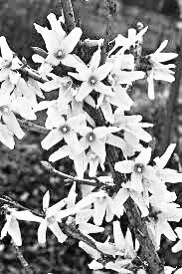
FORSYTHIA
Everyone who lives in our region would easily recognize the Forsythia shrub, even if they don’t know it by name. Forsythia is the first shrub that blooms in the early spring, March and April. It heralds the end of winter and the beginning if spring.
Forsythias’ popularity is due to its bright, golden yellow flowers that bloom on bare branches. They create a spectacular display when other plants are just waking up from their winter dormancy.
Forsythia is native to high elevations in China and have been cultivated in China and Japan for centuries.
Discovered by a Swedish botanist in Japan around 1775/76 Forsythia was first introduced to Holland in 1833. Forsythia then reached England in 1850. Later the plant was named Forsythia after William Forsyth (1737-1804), the superintendent of the Royal Gardens at Kensington and St. James Palaces. Forsythia finally arrived in America in 1917.
Today there are hundreds of Forsythia cultivars for sale. Although the golden yellow is still the most popular, there is also a white variety and lighter shades of yellow available. There are now a few dwarf Forsythia on the market but Forsythia is, for the most part, larger shrubs not suitable for border plantings.
Long lived and hardy, these disease resistance plants can live to be fifty or sixty years old. Many of the problems that Forsythia have, such as stem galls, can be easily corrected simply by pruning the sickly stems off. These galls look like golf balls growing along the branches.
Fast growing plants, Forsythia can be easily propagated from soft or hardwood cutting. In the wild, Forsythia often propagates itself by ‘stem layering’. A branch that hits the ground and becomes covered with soil or leaves develops its own roots and soon becomes its own viable plant. In the home garden this new plant can later be cut away from the original and replanted in a different area. This is a horticulture technique that can be stimulated in the home garden as well.
Propagation from seed takes a long time, up to two years, starting with harvesting seeds and safely overwintering them outdoors. The avid gardener might enjoy trying this but there is no guarantee the offspring will have the desirable qualities of the parent plant.
Since Forsythia are long-lived fast-growing plants, site selection is very important. A mature shrub can reach the height of 8 to 10 feet and 12 feet wide. When planting along a fence line, give plenty of room to avoid unnecessary conflicts with neighbors in the future. Because of its eventual size Forsythias should not be added to a border planting as they will quickly outgrow the space.
According to Michael Dirr, Manual of Woody Landscape Plants“Shrub borders, mass groupings and along banks are the most appropriate sites.” The most spectacular plantings are along fence lines and on roadsides where they have plenty of space and sunlight to grow.
Correctly pruning Forsythia is the key to the most beautiful display in the spring. Since they bloom on last season’s new branches, pruning should be done soon after blooming in the spring. After the leaves grow in, the young buds for next year’s bloom are already formed. Later pruning will remove these flower buds. When pruning, remove the thick old wood in the center to encourage new growth.
Forsythia looks best when they are allowed to maintain their weeping, flowing habit so the less pruning the better. If you prefer your garden tightly pruned with rounded shrubs, Forsythia are not the best selection for you.
Forsythia has been used in traditional Chinese medicine for at least four thousand years. It is still used, often blended with other plants, to treat skin infections, colds, fever and jaundice. Laboratory studies have confirmed its anti-tumor, antibacterial and anti-inflammatory actives.
FORCING FORYSTIA FLOWERS INDOORS
Forcing Forsythia to bloom indoors in early spring is an easy way to bring spring color indoors. Select a branch with as many buds as possible. Give it a good cut on an angle and place it in water. Cutting it on an angle helps the cutting absorb more water. A few hours later give your branch another fresh cut and put it in fresh, clean room temperature water. It’s also a good idea to strip off the flower buds that will be under water since these will rot and possibility smell. A sunny window helps your Forsythia branch flower sooner. Change the water once or twice a week and soon you will have a beautiful display of flowers.
Often these forced braches will develop roots and become a new young plant. Prune off the top of the branch, leaving about eight inches and put it back in fresh water. When the roots are about six to eight inches long it’s time to plant it. Allowing the new root to become too long is not a good idea. These ‘water roots’ have a harder time adjusting to their new life in soil, increasing possibility of failure. Plant your new Forsythia in the garden or directly in a pot if you plan to exchange it at a plant swap or give it as a gift.
The first year is crucial for the new roots to develop so don’t forget to water your young plants at least once a week.
Thanks to the following for the information in this article: Michael Dirr, Manual of Woody Landscape Plants; Smithsonian Museum, ‘Plants Of The World’; and Wyman’s Gardening Encyclopedia.
Happy Springtime everyone,
James
